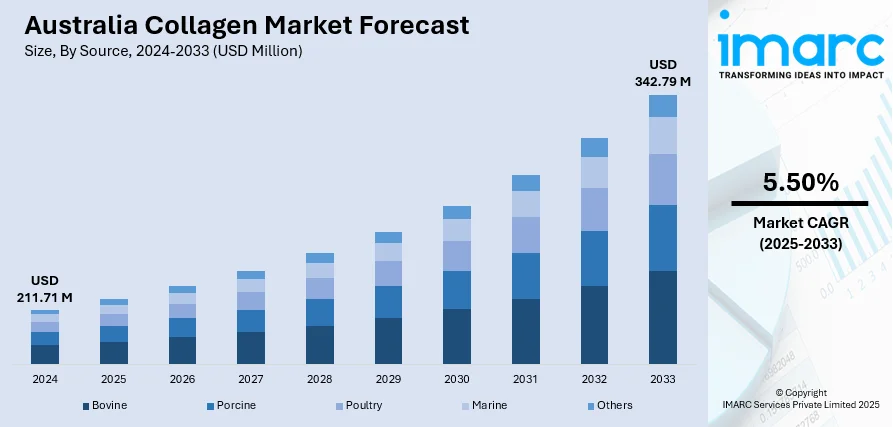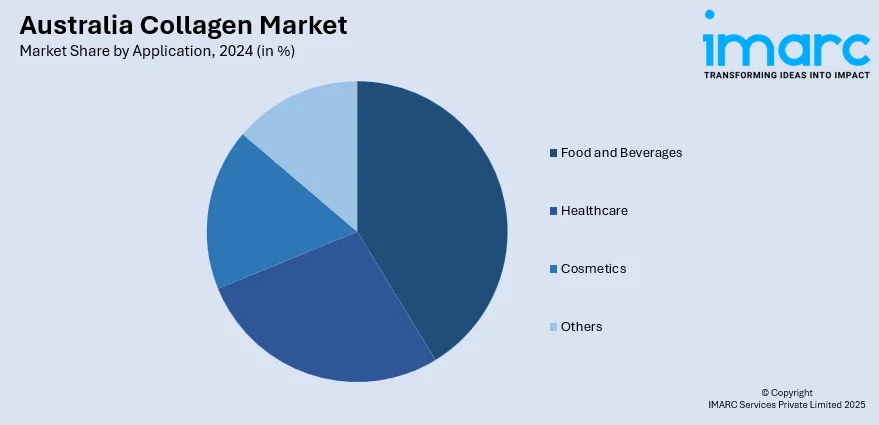
Australia Collagen Market Size, Share, Trends and Forecast by Source, Product, Application, and Region, 2025-2033
Australia Collagen Market Overview:
The Australia collagen market size reached USD 211.71 Million in 2024. Looking forward, IMARC Group expects the market to reach USD 342.79 Million by 2033, exhibiting a growth rate (CAGR) of 5.50% during 2025-2033. The demand for collagen is driven by growing uses in the pharmaceutical and biomedical sectors, where it is used in drug delivery systems, in wound healing products, and in tissue engineering solutions. Moreover, the rise of health consciousness among the masses is supporting the market growth. Apart from this, the heightened demand for effective anti-aging solutions is expanding the Australia collagen market share.
|
Report Attribute
|
Key Statistics
|
|---|---|
|
Base Year
|
2024
|
|
Forecast Years
|
2025-2033
|
|
Historical Years
|
2019-2024
|
| Market Size in 2024 | USD 211.71 Million |
| Market Forecast in 2033 | USD 342.79 Million |
| Market Growth Rate 2025-2033 | 5.50% |
Australia Collagen Market Trends:
Increasing Demand for Functional and Nutraceutical Foods
The Australian market for collagen is experiencing rapid growth as consumers become more health-conscious, with functional foods, drinks, and nutraceuticals leading the trend. Collagen is now being identified for maintaining healthy joints, increasing skin elasticity, and contributing to overall well-being, which follows the rising demand for preventive medicine. Consumers are looking for collagen peptides, powder, and supplement-fortified foods as a part of their regular diets to combat aging issues and lifestyle-related health problems. Food and beverage companies are meeting this demand by adding collagen to protein bars, ready-to-drink beverages, and dietary supplements, thus increasing product availability. The heightened adoption of natural and clean-label ingredients is also further driving the collagen's use in formulations, as it is being recognized as a naturally sourced protein ingredient. This consistent movement toward health-oriented consumption behaviors is consistently catalyzing the collagen demand in the Australian marketplace.

To get more information on this market, Request Sample
Increased Use in the Cosmetics and Personal Care Sector
The Australian collagen market growth is propelled by the beauty and personal care sector increasingly using collagen in skincare, haircare, and cosmetic products. People are giving more priority to anti-aging products targeting wrinkles, fine lines, and hydration of skin, thus making collagen a sought-after ingredient with its regenerative and skin-strengthening attributes. Cosmetic companies are working extensively to create collagen-filled creams, serums, and masks that are stimulating skin firmness and elasticity, targeting both the young age group looking for preventive treatments and aged individuals seeking rejuvenation. Increased usage of natural and bioactive ingredients in cosmetics is also driving collagen adoption, as it is being positioned as a safer and more efficient option compared to man-made substances. Social media popularity, cosmetic trends, and endorsement by dermatologists are boosting collagen awareness owing to its benefits. In 2024, Hemp Foods Australia introduced its initial beauty-from-within supplement, a vegan collagen product aimed at promoting hair, skin, and nails, which it claims may address the need for plant-based alternatives.
Increased Usage in the Pharmaceutical and Biomedical Industry
The demand for collagen is being driven by growing uses in the pharmaceutical and biomedical sectors, where collagen is being used in drug delivery systems, in wound healing products, and in tissue engineering solutions. The biocompatibility and biodegradability of collagen make it a suitable material for use in medical applications, especially in surgical operations, regenerative medicine, and sophisticated wound care therapies. Hospitals and clinics are growing more accustomed to using collagen-based products for recovery after surgery, given that collagen is facilitating quicker healing and enhanced tissue regeneration. Pharmaceutical firms and research centers are making investments in collagen-based technologies such as scaffolds for stem cell therapy and implantable medical devices, further boosting the material's credibility in medical usage. For instance, in 2024, Research conducted by Nisa Salim from Swinburne University’s Engineering School, with backing from the Victorian state government, showed that seafood byproducts can yield high-value collagen suitable for cosmetics, food, and pharmaceuticals. This study could eliminate the reliance on animal-derived collagen sources, providing a potentially more ethical and sustainable option for the market.
Australia Collagen Market Segmentation:
IMARC Group provides an analysis of the key trends in each segment of the market, along with forecasts at the country and regional levels for 2025-2033. Our report has categorized the market based on source, product, and application.
Source Insights:
- Bovine
- Porcine
- Poultry
- Marine
- Others
The report has provided a detailed breakup and analysis of the market based on the source. This includes bovine, porcine, poultry, marine, and others.
Product Insights:
- Gelatin
- Hydrolyzed Collagen
- Native Collagen
- Synthetic Collagen
- Others
A detailed breakup and analysis of the market based on the product have also been provided in the report. This includes gelatin, hydrolyzed collagen, native collagen, synthetic collagen, and others.
Application Insights:

- Food and Beverages
- Functional Food
- Functional Beverages
- Dietary Supplements
- Confectionary
- Desserts
- Meat Processing
- Healthcare
- Bone and Joint Health Supplements
- Wound Dressing
- Tissue Regeneration
- Medical Implants
- Cardiology
- Drug Delivery
- Cosmetics
- Beauty Supplements (Nutricosmetics)
- Topical Cosmetic Products
- Others
The report has provided a detailed breakup and analysis of the market based on the application. This includes food and beverages (functional food, functional beverages, dietary supplements, confectionary, desserts, and meat processing), healthcare (bone and joint health supplements, wound dressing, tissue regeneration, medical implants, cardiology, and drug delivery), cosmetics (beauty supplements (nutricosmetics) and topical cosmetic products), and others.
Regional Insights:
- Australia Capital Territory & New South Wales
- Victoria & Tasmania
- Queensland
- Northern Territory & Southern Australia
- Western Australia
The report has also provided a comprehensive analysis of all the major regional markets, which include Australia Capital Territory & New South Wales, Victoria & Tasmania, Queensland, Northern territory & Southern Australia, and Western Australia.
Competitive Landscape:
The market research report has also provided a comprehensive analysis of the competitive landscape. Competitive analysis such as market structure, key player positioning, top winning strategies, competitive dashboard, and company evaluation quadrant has been covered in the report. Also, detailed profiles of all major companies have been provided.
Australia Collagen Market Report Coverage:
| Report Features | Details |
|---|---|
| Base Year of the Analysis | 2024 |
| Historical Period | 2019-2024 |
| Forecast Period | 2025-2033 |
| Units | Million USD |
| Scope of the Report |
Exploration of Historical Trends and Market Outlook, Industry Catalysts and Challenges, Segment-Wise Historical and Future Market Assessment:
|
| Sources Covered | Bovine, Porcine, Poultry, Marine, Others |
| Products Covered | Gelatin, Hydrolyzed Collagen, Native Collagen, Synthetic Collagen, Others |
| Applications Covered |
|
| Regions Covered | Australia Capital Territory & New South Wales, Victoria & Tasmania, Queensland, Northern territory & Southern Australia, Western Australia |
| Customization Scope | 10% Free Customization |
| Post-Sale Analyst Support | 10-12 Weeks |
| Delivery Format | PDF and Excel through Email (We can also provide the editable version of the report in PPT/Word format on special request) |
Key Questions Answered in This Report:
- How has the Australia collagen market performed so far and how will it perform in the coming years?
- What is the breakup of the Australia collagen market on the basis of source?
- What is the breakup of the Australia collagen market on the basis of product?
- What is the breakup of the Australia collagen market on the basis of application?
- What is the breakup of the Australia collagen market on the basis of region?
- What are the various stages in the value chain of the Australia collagen market?
- What are the key driving factors and challenges in the Australia collagen market?
- What is the structure of the Australia collagen market and who are the key players?
- What is the degree of competition in the Australia collagen market?
Key Benefits for Stakeholders:
- IMARC’s industry report offers a comprehensive quantitative analysis of various market segments, historical and current market trends, market forecasts, and dynamics of the Australia collagen market from 2019-2033.
- The research report provides the latest information on the market drivers, challenges, and opportunities in the Australia collagen market.
- Porter's five forces analysis assist stakeholders in assessing the impact of new entrants, competitive rivalry, supplier power, buyer power, and the threat of substitution. It helps stakeholders to analyze the level of competition within the Australia collagen industry and its attractiveness.
- Competitive landscape allows stakeholders to understand their competitive environment and provides an insight into the current positions of key players in the market.
Need more help?
- Speak to our experienced analysts for insights on the current market scenarios.
- Include additional segments and countries to customize the report as per your requirement.
- Gain an unparalleled competitive advantage in your domain by understanding how to utilize the report and positively impacting your operations and revenue.
- For further assistance, please connect with our analysts.
 Request Customization
Request Customization
 Speak to an Analyst
Speak to an Analyst
 Request Brochure
Request Brochure
 Inquire Before Buying
Inquire Before Buying




.webp)




.webp)












